Ampere Altra 1P Server Pictured: GIGABYTE’s 2U with 80 Arm N1 Cores, PCIe 4.0 and CCIX
by Dr. Ian Cutress on August 3, 2020 5:00 PM EST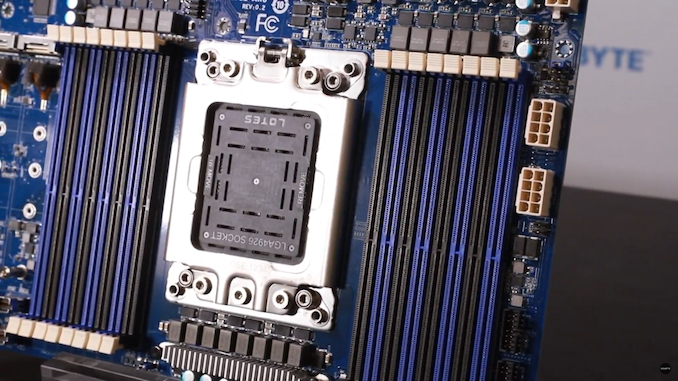
With the news of Apple moving to Arm SoCs replacing Intel in a few key products, and the success of the new Graviton2 SoC in Amazon’s Web Services, the news-o-sphere is awash with excitement about a new era of Arm-based computing. One of the companies looking to deploy Arm into the cloud is Ampere, with its new Altra and Altra Max compute processors.
We’ve covered Altra in some detail, with the aim to offer better-than-Graviton performance and functionality to hyperscalers that don’t have access to Graviton2 (because it’s an Amazon only chip). In June, the company launched its processor list, going from 24 cores all the way up to 80 cores running at 3.3 GHz for 250 W. This processor list is quite possibly the easiest-to-follow naming scheme of any processor list in recent memory. Alongside all those high-performance cores there are 128 PCIe 4.0 lanes, support for CCIX, eight channel DDR4-3200 memory, and a 128-core version coming early next year. It’s a shot well past Graviton, aimed squarely at Xeon and Epyc.
At the announcement of Altra, Ampere stated that it would be developing reference designs for Altra – a single socket called Mt. Snow, and a dual socket called Mt. Jade. GIGABYTE is the first OEM partner to showcase its single socket design, with a dedicated video on the product as part of the GIGABYTE Virtual Show 2020, which replaced its Computex plans.
The R272-P30 server is the Mt. Snow single socket 2U design, built upon GIGABYTE’s MP32-AR0 motherboard, which is an EATX form factor. The motherboard is laid out in order to improve server airflow with a transposed socket, which also helps with supporting all of the sixteen DDR4-3200 memory slots. The Altra socket is a rather substantial LGA4926 socket, indicating 4926 pins within the bracket, with the bracket held on by five Torx screws (EPYC uses three by comparison). Supporting the socket is an 8-phase server-grade power delivery, which seems minuscule by consumer standards but is probably overkill here.
The motherboard has two PCIe 4.0 x16 full-length slots and four PCIe 4.0 x8 full-length slots, plus another PCIe 4.0 x8 half-length slot. Management is through the popular Aspeed AST2500 BMC implementation, while onboard Ethernet uses a dual Intel I350 solution. There are four slimline U.2 ports, as well as eight min-SAS breakout headers and an OCP 2.0 PCIe 3.0 slot for add-in OCP solutions.
The server as presented by GIGABYTE had seven PCIe breakout cards installed, leading to 24x PCIe 4.0 NVMe x4 storage at the front of the chassis. Ultimately this solution is for a fast-storage cloud deployment, and is one of the first Altra-based servers that GIGABYTE is developing. Ampere is a key partner with NVIDIA in order to provide CUDA-on-Arm solutions, so we suspect a GPGPU variant might be in the works as well.
| Ampere 1st Gen Altra 'QuickSilver' Product List |
||||||
| AnandTech | Cores | Frequency | TDP | PCIe | DDR4 | Price |
| Q80-33 | 80 | 3.3 GHz | 250 W | 128x G4 | 8 x 3200 | ? |
| Q80-30 | 80 | 3.0 GHz | 210 W | 128x G4 | 8 x 3200 | ? |
| Q80-26 | 80 | 2.6 GHz | 175 W | 128x G4 | 8 x 3200 | ? |
| Q80-23 | 80 | 2.3 GHz | 150 W | 128x G4 | 8 x 3200 | ? |
| Q72-30 | 72 | 3.0 GHz | 195 W | 128x G4 | 8 x 3200 | ? |
| Q64-33 | 64 | 3.3 GHz | 220 W | 128x G4 | 8 x 3200 | ? |
| Q64-30 | 64 | 3.0 GHz | 180 W | 128x G4 | 8 x 3200 | ? |
| Q64-26 | 64 | 2.6 GHz | 125 W | 128x G4 | 8 x 3200 | ? |
| Q64-24 | 64 | 2.4 GHz | 95 W | 128x G4 | 8 x 3200 | ? |
| Q48-22 | 48 | 2.2 GHz | 85 W | 128x G4 | 8 x 3200 | ? |
| Q32-17* | 32 | 1.7 GHz | 58 W | 128x G4 | 8 x 3200 | ? |
| Q32-17 | 32 | 1.7 GHz | 45 W | 128x G4 | 8 x 3200 | ? |
| *With 4 TiB DRAM Installed | ||||||
Ampere recently announced that the first cloud instances on Altra were starting to come online, starting with Packet as part of the Early Access Program. Wider general availability is expected through the rest of the year. We’re already on the list for a review sample!
Source: GIGABYTE
Related Reading
- Next Generation Arm Server: Ampere’s Altra 80-core N1 SoC for Hyperscalers against Rome and Xeon
- Ampere’s Product List: 80 Cores, up to 3.3 GHz at 250 W; 128 Core in Q4
- Avantek's Arm Workstation: Ampere eMAG 8180 32-core Arm64 Review
- Arm Development For The Office: Unboxing an Ampere eMag Workstation
- Amazon's Arm-based Graviton2 Against AMD and Intel: Comparing Cloud Compute


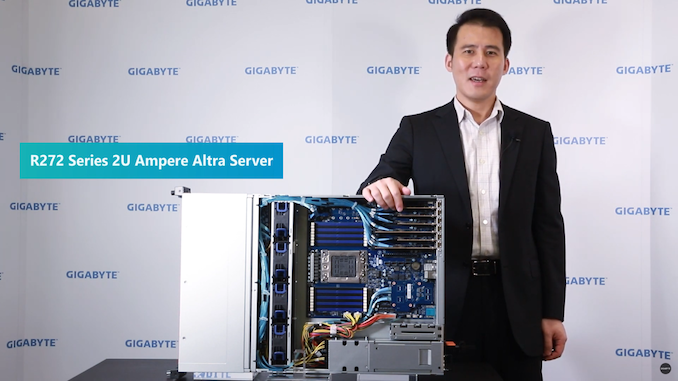

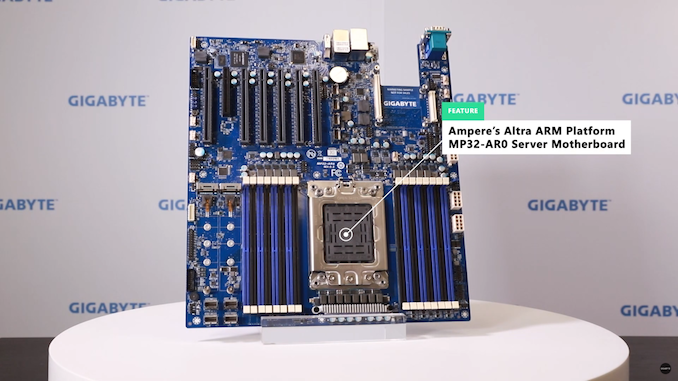
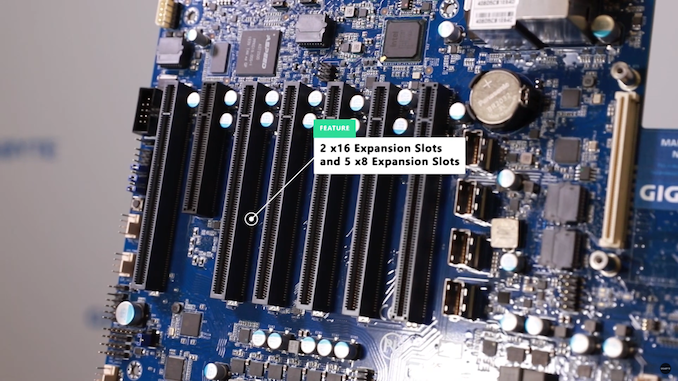

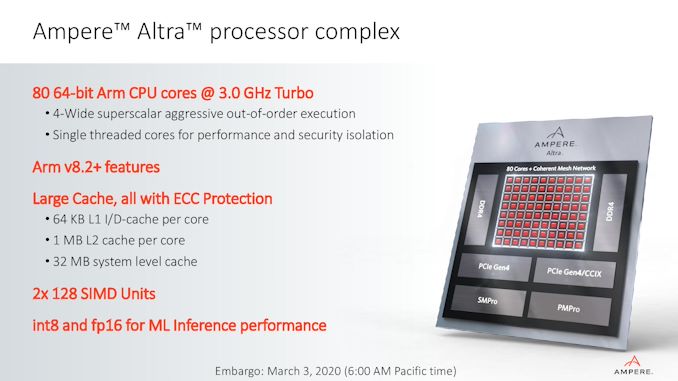








10 Comments
View All Comments
anonomouse - Monday, August 3, 2020 - link
Odd that they don't have an R28x or R29x series 2P 2U system like they do for SKX-SP/CSX-SP/CPL-SP/TX2/Naples/Rome, since those series seem to be the workhorse dense compute+storage systems. You'd assume that they'd be responsive to customer demand, so one might think that implies a lack of interest in a platform directly competitive with those incumbents, which would not be promising for Ampere...For comparison, they already announced an R282 with ThunderX3.
brucethemoose - Monday, August 3, 2020 - link
How do y'all plan to benchmark Altra? Will it be compared against x86? And will y'all run native ARM binaries?If ya'll are looking for suggestions, how about ARM video encoding? Some of the AV1 encoders already have NEON support built in, and AV1an is great at spreading the load out to many cores: https://github.com/master-of-zen/Av1an
In a way, its apples to oranges, as the amount of effort put into SIMD optimization on ARM and x86 will be different, and all the AV1 encoders/decoders are WIP, but it could still be an interesting comparison!
I have some other benchmark ideas, but I need to check if they'll even run/compile on ARM...
rahvin - Monday, August 3, 2020 - link
The testing should use the server bench marking systems they've developed.jonmasters - Monday, August 3, 2020 - link
And it looks like socketed flash too! Appears to be two modules (either BMC+AP, or combo with a backup). Either way, that's a nice touch!Samus - Tuesday, August 4, 2020 - link
Are those 3.3GHz on all 80 cores simultaneously?Samus - Tuesday, August 4, 2020 - link
oh nvm I see 3GHz x 80Wilco1 - Tuesday, August 4, 2020 - link
Yes, and indefinitely since that's the base frequency.Spunjji - Wednesday, August 5, 2020 - link
Looking good! Really glad to see companies pushing ARM back into the server space, after the initial false-starts.MASSIVE kudos to them for their CPU naming scheme, too. Seems like something both AMD and Intel could learn from (with a sterner eye on Intel, because theirs is truly batshit).
GreenReaper - Thursday, August 6, 2020 - link
Yeah, I had an ARM server back when OVH was trialling them; they work, especially for content distribution, it's just a matter of having the platform (storage, network, etc.) up to standard.Tomatotech - Wednesday, August 5, 2020 - link
2021: Your storage gumstick runs an embedded ARM CPU that is powerful enough to run Linux decently well in its own right, sending data to your ARM main CPU via the ARM secure encryption chip on your Apple laptop, pulling data from an ARM-equipped datacentre, while you talk on your ARM CPU powered high-spec phone, driving your car stuffed full of ARM chips, while munching on a sandwich from your ARM-embedded toaster as your ARM-chipped fridge orders more cheese for tomorrow.